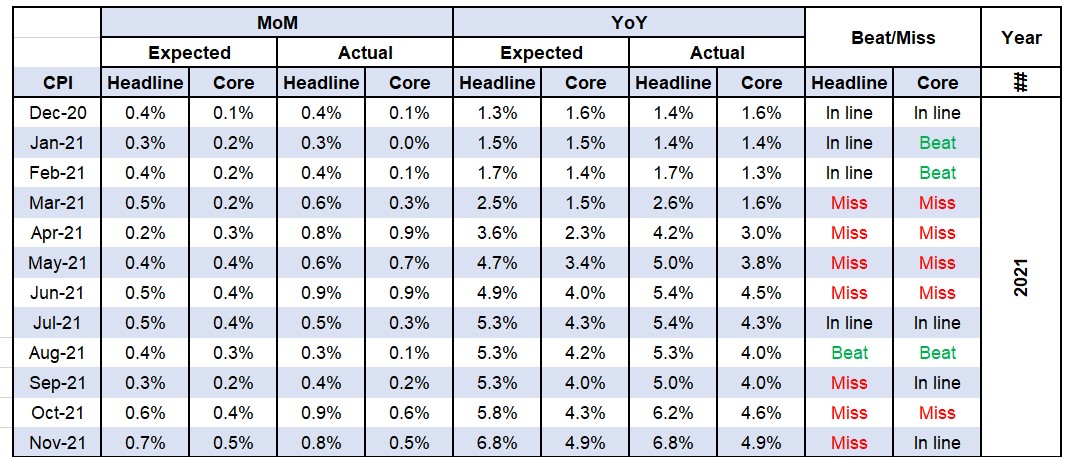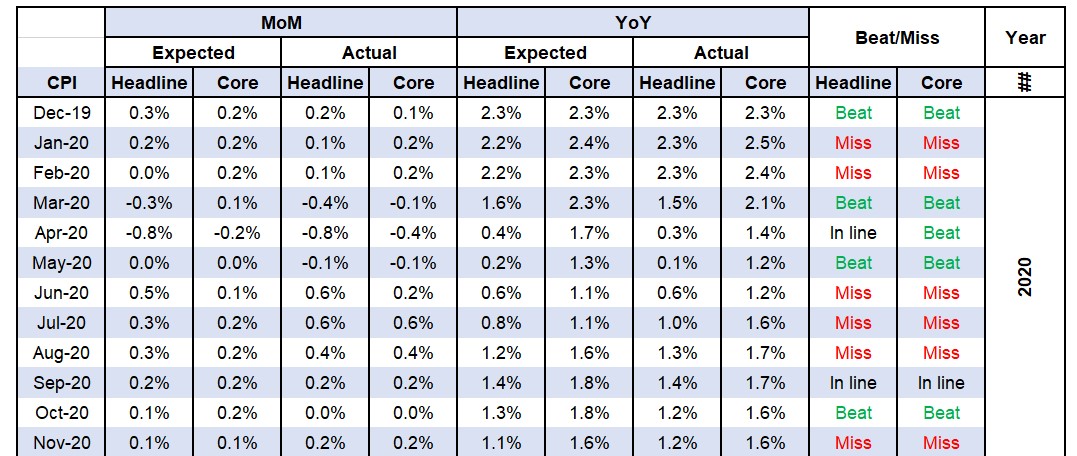
Q4 #GDP advance print shows 2.9% after 3.2% in Q3.
2 positive Qs after 2 negative Qs suggest there is no #recession.
Now that #inflation is nonexistent, a non-#recession would actually mean a soft landing.
Is that plausible?
A comprehensive 🧵.
1/22
2 positive Qs after 2 negative Qs suggest there is no #recession.
Now that #inflation is nonexistent, a non-#recession would actually mean a soft landing.
Is that plausible?
A comprehensive 🧵.
https://twitter.com/MBjegovic/status/1613624020020383746?s=20&t=vQglbAFt6C8ZJKleFPkP0A
1/22
Before we go into the #GDP details, let's delve deeper into the #recession data.
Since 1954 there were 10 recessions and ALL came after the #Fed hiked rates.
There were only 3 instances when their hikes didn't cause a #recession:
1) 1961-1966
2) 1983-1984
3) 1994-1995
2/22
Since 1954 there were 10 recessions and ALL came after the #Fed hiked rates.
There were only 3 instances when their hikes didn't cause a #recession:
1) 1961-1966
2) 1983-1984
3) 1994-1995
2/22

During the latest hiking cycle the #Fed added 425 bps in 9M.
The highest they ever managed to hike in 9M without causing a #recession was (only) 190 bps.
IOW soft landing with this amount of hikes has never happened!
3/22
The highest they ever managed to hike in 9M without causing a #recession was (only) 190 bps.
IOW soft landing with this amount of hikes has never happened!
3/22
The #Fed officials keep talking about further hikes going to 5%+ terminal rate and keeping it there until at least 2024 - "higher for longer"
The last time they hiked to that level, they caused the most severe #recession (the GFC) since the Great Depression.
4/22
The last time they hiked to that level, they caused the most severe #recession (the GFC) since the Great Depression.
4/22

In 2 yrs from 2004 to 2006 the #Fed hiked 425 reaching 5.25% and kept it there for 1 yr until they started cutting again.
The #recession they caused was so large that they had to introduce (unprecedented) ZIRP, CE and QE, as well as bail out troubled financial institutions
5/22
The #recession they caused was so large that they had to introduce (unprecedented) ZIRP, CE and QE, as well as bail out troubled financial institutions
5/22
Worth to note that the #Fed hikes prior to the most recent cycle were done with expanding M2.
Today situation is different bc M2 has been contracting since May 2022.
This adds to the economic downturn.
#recession
6/22
Today situation is different bc M2 has been contracting since May 2022.
This adds to the economic downturn.
#recession
6/22

Back to the Q4 #GDP.
+2.9% is an advance print that may change the #GDP picture with revisions in the coming Ms.
For example Q3 advance print showed +2.6% that was since revised to 3.2%.
Advance print showed -0.2% ex-net exports but revisions brought it to +0.3% now.
7/22
+2.9% is an advance print that may change the #GDP picture with revisions in the coming Ms.
For example Q3 advance print showed +2.6% that was since revised to 3.2%.
Advance print showed -0.2% ex-net exports but revisions brought it to +0.3% now.
7/22

Some interesting developments in the details of the #GDP with personal consumption (+1.42%) slowing a bit from Q3 levels (+1.54%).
This was primarily due to weaker services (+1.16% vs +1.63%), while goods consumption went positive (+0.26%) after 3 consecutive negative Qs.
8/22
This was primarily due to weaker services (+1.16% vs +1.63%), while goods consumption went positive (+0.26%) after 3 consecutive negative Qs.
8/22

Also investments went positive (+0.27%) after 2 consecutive negative Qs solely due to higher inventories (+1.46% after 2 consecutive negative Qs).
Fixed investments were down -1.20% primarily due to negative housing investments (-1.29%).
#GDP
9/22
Fixed investments were down -1.20% primarily due to negative housing investments (-1.29%).
#GDP
9/22
Net exports slowed substantially (+0.56% vs +2.86% in Q3) with falling exports (-0.15% vs +1.65 in Q3) and lower imports growth (+0.71% vs +1.21% in Q3).
As I mentioned before this is due to an inverse J-Curve in a stronger #USD environment.
#GDP
10/22
As I mentioned before this is due to an inverse J-Curve in a stronger #USD environment.
#GDP
https://twitter.com/MBjegovic/status/1586077385757458432?s=20&t=FlUfjVezRLtjKDSgVNT4zg
10/22
Government consumption (+0.64%) had virtually identical impact as in Q3 (+0.65%).
Overall, consumption of services is easing, while consumption of goods only picked up due to motor vehicles, food and gasoline as a direct result of lower prices of these products.
#GDP
11/22
Overall, consumption of services is easing, while consumption of goods only picked up due to motor vehicles, food and gasoline as a direct result of lower prices of these products.
#GDP
11/22
Pickup in goods consumption is probably unsustainable bc vehicle demand is largely driven (not by price levels but) by the availability of the credit and credit conditions have tightened a lot with the #Fed hikes.
Also there is only so much of food ppl can consume.
#GDP
12/22
Also there is only so much of food ppl can consume.
#GDP
12/22
Gasoline consumption can be volatile picking up when prices are going down, and not necessarily rising if the prices go back up or remain where they are for some time.
Given the trend and rate levels nonresidential investments could go negative in the coming Qs.
#GDP
13/22
Given the trend and rate levels nonresidential investments could go negative in the coming Qs.
#GDP
13/22
Inventories could continue to have a positive contribution but will likely remain offset by negative fixed investments.
Due to already mentioned inverse J-Curve, net exports would likely return back to their normal negative contributions:
#GDP
14/22
Due to already mentioned inverse J-Curve, net exports would likely return back to their normal negative contributions:
https://twitter.com/MBjegovic/status/1586077365608001538?s=20&t=SphAPHUyKFKhSH9F2s-OVA
#GDP
14/22
Government could try to increase their spending as a way of offsetting the negative impacts of other #GDP components
but with 10Y at around 3.5% issuance of new debt has become quite more expensive compared to around 1.5% levels a year ago.
15/22
but with 10Y at around 3.5% issuance of new debt has become quite more expensive compared to around 1.5% levels a year ago.
15/22
Although 3.5% is somewhat less than 4.2% we had seen 3M ago, this is still a significantly higher rate than what the government had in prior years.
So unless the #Fed cuts substantially, the government's impact on the #GDP will likely remain limited.
16/22
So unless the #Fed cuts substantially, the government's impact on the #GDP will likely remain limited.
16/22
This pickup in aggregate demand is likely temporary and unsustainable.
Consumption, investments and net exports will likely fall in the coming Qs, while government spending likely won't be enough to offset the overall decline.
What gives conviction about this?
#GDP
17/22
Consumption, investments and net exports will likely fall in the coming Qs, while government spending likely won't be enough to offset the overall decline.
What gives conviction about this?
#GDP
17/22
#Fed hikes don't kick in right away but work with lags.
Everything the #Fed did (pent-up slowdown) in the last 9M is not visible yet.
Not even the smallest 25 hike from Mar has taken a full effect yet, let alone all other giant ones that followed:
18/22
Everything the #Fed did (pent-up slowdown) in the last 9M is not visible yet.
Not even the smallest 25 hike from Mar has taken a full effect yet, let alone all other giant ones that followed:
https://twitter.com/MBjegovic/status/1610989190153670659?s=20&t=9U59RmvDHlF8G5cnHtBxaA
18/22
Now the obvious Q is what will happen when all of these hikes take full effect?
The #Fed's 425 (and counting) hike carries a pent-up #recession.
And the severity of this #recession will depend on the #Fed's next moves.
19/22
The #Fed's 425 (and counting) hike carries a pent-up #recession.
And the severity of this #recession will depend on the #Fed's next moves.
19/22
OOH the #Fed still has room to moderate the effect of the hikes if it would to cut soon and by considerable amount.
OTOH the #Fed keeps talking about further (albeit lower) hikes and keeping the FFR high which could make #recession quite severe.
So what will the #Fed do?
20/22
OTOH the #Fed keeps talking about further (albeit lower) hikes and keeping the FFR high which could make #recession quite severe.
So what will the #Fed do?
20/22
These threads take a lot of time and effort to write.
If you like the content, please love and retweet to help me spread the message.
21/22
If you like the content, please love and retweet to help me spread the message.
21/22
I'm going to dig deeper into what will the #Fed do and when, as well as how will that impact the #economy and the mkts going forward at my next
Pick Marko's Brain Workshop on Tuesday Feb 7 at 1 pm ET.
DM me to reserve your spot!
22/22
Pick Marko's Brain Workshop on Tuesday Feb 7 at 1 pm ET.
DM me to reserve your spot!
22/22
• • •
Missing some Tweet in this thread? You can try to
force a refresh














